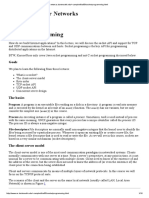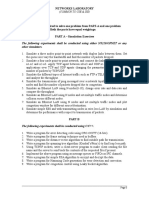End Ian
End Ian
Uploaded by
Cassiano R. N. MorallesOriginal Description:
Copyright
Available Formats
Share this document
Did you find this document useful?
Is this content inappropriate?
Report this DocumentCopyright:
Available Formats
End Ian
End Ian
Uploaded by
Cassiano R. N. MorallesCopyright:
Available Formats
Exploring Endian
As you read from Section 3.2 of TCP/IP Sockets in C: Practical Guide for Programmers, different architectures use different byte ordering for multibyte quantities. A big-endian machine places the most significant byte in the lowest address while a little-endian machine places the least significant byte in the lowest address. To avoid confusion when communicating between different architectures, the Sockets interface specifies a standard byte ordering called networkbyte order, which happens to be big-endian. Consequently, all network communication should be big-endian, irrespective of the client or server architecture. Sockets provides a set of macros to convert to and from host to network byte order(i.e., [hn]to[nh][sl]( )). Consider the following C program: #include <stdio.h> main() { int i; long x = 0x112A380; unsigned char *ptr = (char *) &x;
/* Loop variable */ /* Value to play with */ /* Byte pointer */
/* Observe value in host byte order */ printf("x in hex: %x\n", x); printf("x by bytes: "); for (i=0; i < sizeof(long); i++) printf("%x\t", ptr[i]); printf("\n"); /* Observe value in network byte order */ x = htonl(x); printf("\nAfter htonl()\n"); printf("x in hex: %x\n", x); printf("x by bytes: "); for (i=0; i < sizeof(long); i++) printf("%x\t", ptr[i]); printf("\n"); } This program shows how the long variable x with value 112A380 (hexadecimal) is stored. When this program is executed on a little-endian processor, it outputs the following: x in hex: 112a380 x by bytes: 80 a3 After htonl() x in hex: 80a31201 x by bytes: 1 12
12
a3
80
When we examine the individual bytes of x, we find the least significant byte (0x80) in the lowest address. After we call htonl( ) to convert to network byte order, we get the most significant byte (0x1) in the lowest address. Of course, if we try to print the value of x after converting its byte order, we get a meaningless number. Lets execute the same program on a big-endian processor: x in hex: 112a380 x by bytes: 1 12 After htonl() x in hex: 112a380 x by bytes: 1 12
a3
80
a3
80
Here we find the most significant byte (0x1) in the lowest address. Calling htonl( ) to convert to network byte order does not change anything because network byte order is already big endian.
You might also like
- Socket Programming BasicsDocument69 pagesSocket Programming BasicsmiraclesureshNo ratings yet
- EE450 SocketProgrammingProject Fall2015Document25 pagesEE450 SocketProgrammingProject Fall2015nikhilnarangNo ratings yet
- CoffeDocument13 pagesCoffeCharan C GNo ratings yet
- CS 50 Software Design and Implementation Socket Programming: GoalsDocument20 pagesCS 50 Software Design and Implementation Socket Programming: GoalsUtsav DubeyNo ratings yet
- Network ProgrammingDocument23 pagesNetwork ProgrammingAntony JohnNo ratings yet
- Computer Networks Lab: 1) Write A Program For Distance Vector Algorithm To Find Suitable Path For TransmissionDocument20 pagesComputer Networks Lab: 1) Write A Program For Distance Vector Algorithm To Find Suitable Path For TransmissionirshadNo ratings yet
- Programming1 Lecture 4Document27 pagesProgramming1 Lecture 4MustafaNo ratings yet
- Cgi 0002 Serial MSCOMMDocument7 pagesCgi 0002 Serial MSCOMMAndrésMateoNo ratings yet
- Distributed Systems Lab ProgramsDocument23 pagesDistributed Systems Lab Programsgoodsp_007No ratings yet
- CN Lab Manual PDFDocument25 pagesCN Lab Manual PDFDarshan R ShahNo ratings yet
- ECE 5315: Project 3: Simulation of Pipelined Floating Point Processor Design: Pipelined FP AdderDocument3 pagesECE 5315: Project 3: Simulation of Pipelined Floating Point Processor Design: Pipelined FP AdderSiddarth VenkatramanNo ratings yet
- CNLab ManualDocument39 pagesCNLab Manualkakumanuanitha0308No ratings yet
- Pps MRC SolutionDocument45 pagesPps MRC Solutionsourabh saxenaNo ratings yet
- Report Chat ApplicationDocument15 pagesReport Chat ApplicationBritish EmpireNo ratings yet
- 8.6. 2 Lab1Document9 pages8.6. 2 Lab1Mai Huy HoàngNo ratings yet
- CN Lab Part B Exp 1 and 2Document11 pagesCN Lab Part B Exp 1 and 2Vignesh H VNo ratings yet
- Lab 2Document8 pagesLab 2SAURABH DEGDAWALANo ratings yet
- Ns 2 Part 1Document7 pagesNs 2 Part 1Ketan DasNo ratings yet
- Socket ProgrammingDocument16 pagesSocket ProgrammingVivek kumarNo ratings yet
- Sockets Tutorial: The Client Server ModelDocument14 pagesSockets Tutorial: The Client Server ModelAnant Saraswat100% (1)
- 8.7. 3 Lab2Document10 pages8.7. 3 Lab2Mai Huy HoàngNo ratings yet
- Writing Endian-Independent Code in CDocument10 pagesWriting Endian-Independent Code in Chhung516No ratings yet
- Socket Programming: Babak Esfandiari (Based On Slides by Qusay Mahmoud)Document37 pagesSocket Programming: Babak Esfandiari (Based On Slides by Qusay Mahmoud)ris0201No ratings yet
- Report Chat ApplicationDocument15 pagesReport Chat ApplicationBritish EmpireNo ratings yet
- PF Week 4Document6 pagesPF Week 4alicaptain533No ratings yet
- My CSC2402 NotesDocument47 pagesMy CSC2402 NotesKo KhanNo ratings yet
- Understanding EndiannessDocument9 pagesUnderstanding Endiannessswapnil kingeNo ratings yet
- Applications of Pointers in CDocument8 pagesApplications of Pointers in Cmichal hanaNo ratings yet
- Practical-1: Aim: Write A C Program To Implement CRC AlgorithmDocument43 pagesPractical-1: Aim: Write A C Program To Implement CRC Algorithmjlrangani28No ratings yet
- Terminal SoftwareDocument17 pagesTerminal SoftwareAchraf BourassNo ratings yet
- CRC Leaky Bucket AlgorithmDocument7 pagesCRC Leaky Bucket Algorithmy_satyapNo ratings yet
- TechCorner 30 - Convert From ASCII To Ethernet or Serial in Just 15 Minutes!!Document8 pagesTechCorner 30 - Convert From ASCII To Ethernet or Serial in Just 15 Minutes!!QuantumAutomationNo ratings yet
- NetworkingDocument8 pagesNetworkingMasterNo ratings yet
- SNMP User Based SM MibDocument15 pagesSNMP User Based SM MibYudi Gawang Sport SetyawanNo ratings yet
- BCSL 056 Network Programming and Administration Lab 2019 20Document13 pagesBCSL 056 Network Programming and Administration Lab 2019 20Prashant MishraNo ratings yet
- Control Your PC From AnywhereDocument3 pagesControl Your PC From Anywhere20-CM-040 Chilakani Mahesh BabuNo ratings yet
- Assign 3Document5 pagesAssign 3api-252659046No ratings yet
- BARCO DP20k ProtocolDocument25 pagesBARCO DP20k Protocoloscar_gar75No ratings yet
- Unit IiiDocument30 pagesUnit Iiisusan babuNo ratings yet
- 21bee0278 Da 2Document8 pages21bee0278 Da 2Raynier SenpaiNo ratings yet
- How To C Chat ServerDocument19 pagesHow To C Chat ServerSzelSzabNo ratings yet
- VariablesDocument27 pagesVariablesErnest BarreraNo ratings yet
- Lecture 4Document21 pagesLecture 4Amrendra KumarNo ratings yet
- Using The Serial Port With A MATLAB GUIDocument34 pagesUsing The Serial Port With A MATLAB GUIJeya RamanNo ratings yet
- CN Lab ProgramsDocument36 pagesCN Lab ProgramsKavitha SANo ratings yet
- Sockets ProgrammingDocument10 pagesSockets ProgrammingdNo ratings yet
- Iot Lab Extra QuestionsDocument10 pagesIot Lab Extra Questionsjoker145gokulNo ratings yet
- 3.3 Winsock Other FunctionsDocument8 pages3.3 Winsock Other FunctionsMy ReviewNo ratings yet
- Computer Networks: Vii SemesterDocument40 pagesComputer Networks: Vii SemesterAvinash Avi VNo ratings yet
- Computer Networks PracticalDocument30 pagesComputer Networks PracticalKaushik MazumderNo ratings yet
- Net2 PDFDocument38 pagesNet2 PDFMalleshNo ratings yet
- Socket Programming: Sirak Kaewjamnong Computer Network SystemsDocument32 pagesSocket Programming: Sirak Kaewjamnong Computer Network SystemsaymanyaNo ratings yet
- Unit-1.6b - Functions in C++Document14 pagesUnit-1.6b - Functions in C++Vedant AmonkarNo ratings yet
- Learn Arduino: Lecture 10Document19 pagesLearn Arduino: Lecture 10Ahmed Musa ShakirNo ratings yet
- What Is PreprocessorDocument15 pagesWhat Is Preprocessorsuganthi31No ratings yet
- Introduction To Socket ProgrammingDocument8 pagesIntroduction To Socket ProgrammingAngayarkanniNo ratings yet
- Python Unit 04Document48 pagesPython Unit 04Free fire GarenaNo ratings yet



























































